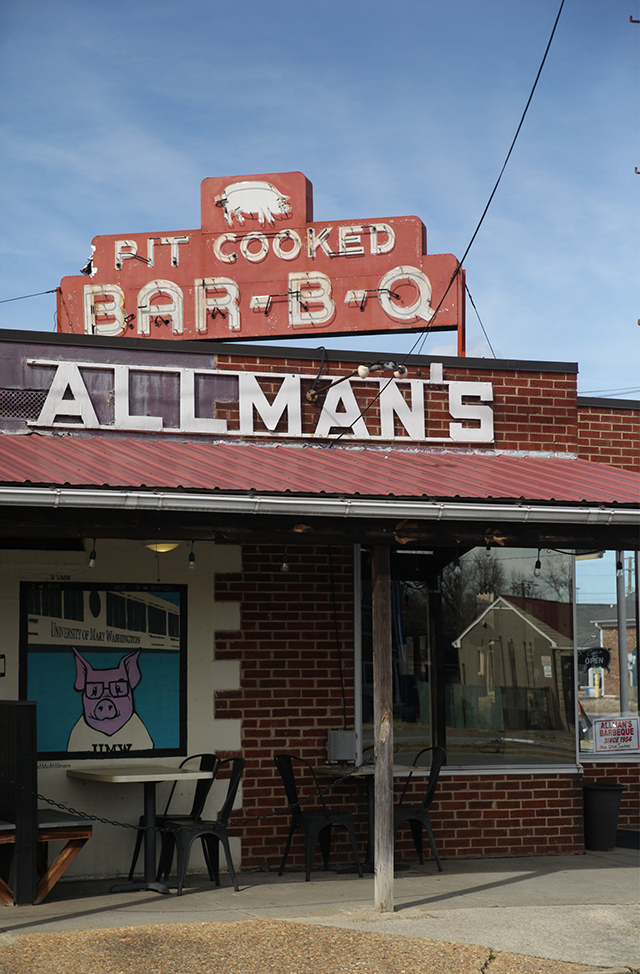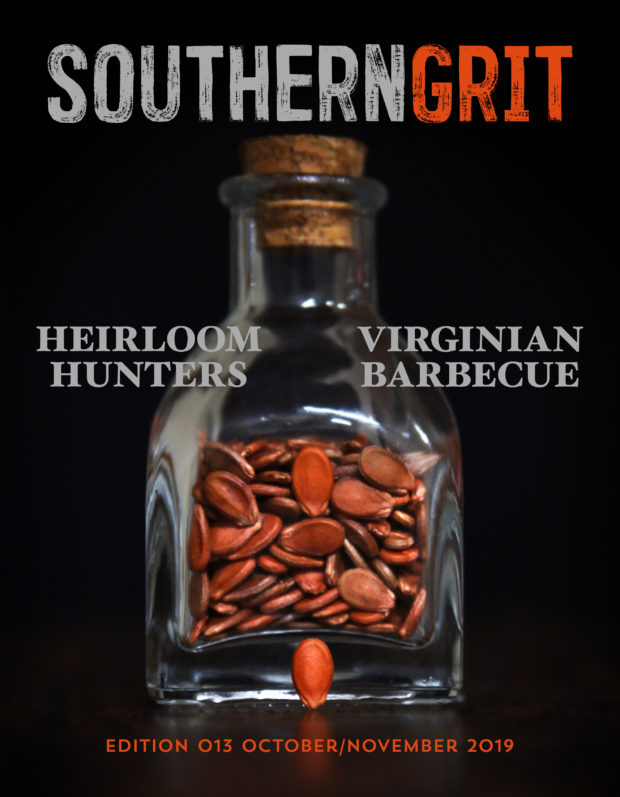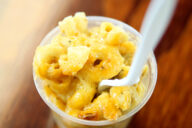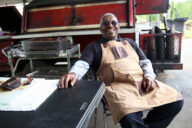Article and photography by Joshua Fitzwater
Allman’s Bar-B-Q is unequivocally a historic Fredericksburg barbecue destination. Opened officially as a barbecue spot in 1954, it has had its ups and downs over the years if you talk to locals. Some might even argue that its true days of barbecue glory ended in the late 1980’s. Since then, Allman’s has mostly stayed afloat in large part due to its endearingly nostalgic exterior facade and the intriguing history of past owners, cooks and signage hanging on its walls.
It’s hard to argue for some that the barbecue and food are the central draw, particularly in the last decade. What’s kept it in business is a loyal clientèle, often seniors and those in their middle ages content with familiarity and forgiving when it comes to the cue. With the recent addition of Matthew Deaton as chef, pitmaster and part owner in Allman’s, there is no doubt in the possibility for improvement. Don’t be confused, however. If a positive change is in the works, it will not be a return to the glory days of Allman’s past. Deaton, despite many misleading media accounts as of late, has made it clear he is going his own way and in no substantial fashion will be looking back at Allman’s heyday.

Street view of Allman’s Bar-B-Q in Fredericksburg, Virginia
Originally constructed in 1949 as a neighborhood market, Allman’s as a barbecue restaurant officially opened in 1954 and was founded by James “Pappy” Allman. According to Virginia barbecue history author Joseph R. Haynes on his Obsessive Compulsive Barbecue blog, who was also an employee of Allman’s in the ‘70s and ‘80s, Allman’s after its inception quickly became, “one of the three legendary food destinations in the town [along with] Carl’s “Ice Cream” Stand […] and the Pool Room.”
In 1967 when Pappy retired, the business stayed in the family, and his son-in-law E.W. “Pete” White took the reins. Mr. White, as young Haynes referred to him when addressing his boss, worked with Pappy from the onset of the business. By most accounts in the ‘70s and ‘80s, Allman’s essentially operated with the same ethos as it did in the years when Pappy Allman was at the helm. According to Haynes, during the late ‘70s and early ‘80s, “it was common to have a line of people waiting to get into the restaurant before it opened at 11 a.m. on weekdays and Saturdays, and 1 p.m. on Sundays.”

Street view of Allman’s Bar-B-Q
One of the main draws that created such fervor for Allman’s barbecue was the way in which it was served and the hours in which it was made. As Haynes details, “Mr. White would be chatting with customers sitting at the counter while manning the sandwich making station behind the center of the counter. As the wait staff took orders from customers filling the tables, Mr. White would be pulling warm, juicy, tender pork barbecue from the shoulders, filling fresh hamburger buns with it and heating it in a ‘griddle press.’ ”
As Haynes further details, “every night at about 8:30 p.m […] a delivery truck straight from the meat packers would deliver about 35 to 40 whole fresh pork shoulders. We would remove them from the boxes and place them directly in the cooker fat side down. Once the cooker was loaded up, the shoulders would cook at about 225 degrees Fahrenheit until opening time at 11 a.m. the next morning.”
It was this process that ensured the freshest barbecue possible was served to eager customers, and they were further enticed by the visual of hot steaming meat being sliced directly in front of them. It is important to note that this process in Allman’s past, though not the same, is not unlike the “show me” Texas barbecue style of service so popular today of cutting and weighing freshly smoked barbecue in front of customers. One could argue that this is one of the reasons Texas style barbecue has eclipsed all other genres of barbecue in America in terms of popularity today. It is also important to note the Virginia tradition of barbecue service, both seen at Allman’s in the past and at other barbecue restaurants in the commonwealth’s past, likely parallels or possibly predates the Texas barbecue serving style.

Allman’s pitmaster, chef, and part owner, Matthew Deaton
For at least the past decade, this approach to barbecue service at Allman’s has been abandoned and Deaton’s new direction will not include it either. Deaton, as he explained, is interested in a, “soulful experience, not showy like the Texas experience in a line. I want it to be more homey. I want it to feel super comfortable.”
When asked about the history of barbecue at Allman’s and greater Virginia as a whole, how it is perceived and how to understand the barbecue at Allman’s now under his new leadership he explained, “we do call it Virginia barbecue. Allman’s has been around since 1954 and Virginia was before North Carolina. It’s vinegar based and it goes with pork. The Carolinas don’t own that. It’s hard to say if you look at the history that [barbecue] didn’t start here [in Virginia] but I often worry about definitions. I’ve always hated getting pinned in. It can hamstring you. Evolution is key.”

Barbecue pork sandwich with slaw and house-made pickles
When Deaton was asked if he plans to keep or explore anything from Allman’s past, he explained, “we are keeping a few things – the sauce recipe and the same thing with the slaw. It’s a stable in this town. Outside of those two things, we are going back to home cooking which we feel was lacking here. We’re putting more love into the food. I’m interested in not only honoring the past but also honoring now. If you put love into the food, people will come.”
——————————————————————————————————–

Select back issues of Southern Grit Magazine available for purchase at www.southerngritmagazine.bigcartel.com
——————————————————————————————————–
Spending time with Deaton, the way he describes his approach to food sounds a lot like a New Southern and farm to table approach, and when done sincerely, it can lead to great results. Deaton’s stew offerings, for example, are a new addition to the menu at Allman’s that a discerning palate can tell are seasonal and are also garnering rather positive responses online. Offerings like this, including seasonal desserts, fit with words he recently shared concerning his approach to food. “I like to keep food pure and simple. I let the meat speak for itself. I’m constantly thinking about paying tribute to the ingredients. I want to pay homage to the people who grew those animals and vegetables,” said Deaton.
Deaton’s approach to food was shaped at some rather notable restaurants he’s worked at in past years and there is no denying he is well traveled in both the barbecue and culinary world. A self-described Air Force brat, Deaton would first come to call Chicago home, living there in the late ‘70s through the ‘80s. Along his diverse culinary path, he most notably worked under barbecue pitmaster and legend Sam Jones of Skylight Inn in Ayden, North Carolina and later under acclaimed James Beard House Chef Joy Crump of Foode and Mercantile both in Fredericksburg.

Deaton barbecuing pork ribs at Allman’s Bar-B-Q
Today, Deaton is often seen outside barbecuing meat behind Allman’s. His pork ribs, as is the case with his stews, also received early praise online, although this is another departure from the glory days of Allman’s past, as ribs were not part of the menu in the ‘70s and ‘80s according to Haynes’ writings on the restaurant.

Half rack of pork spare ribs cut and stacked with collards, slaw and house-made pickles
Under Deaton’s leadership, it seems quite plausible that the food and barbecue at Allman’s will improve in quality from recent years. Having said that, it also seems clear that a return to Allman’s barbecue glory days and history of the further past do not seem in the works, at least not in the style that made the restaurant a barbecue institution. For contextual purposes, if Deaton is successful with his new direction, one might find the barbecue and food experience at Allman’s to be more akin to say a Ruthie’s All Day in Arlington, but Allman’s is even more casual, homey and exists in a greater blue collar realm.
Historical accounts for this article referenced from conversations with Joseph R. Haynes and his writing on Allman’s Bar-B-Q found online at ocbarbecue.blogspot.com/2012/02/where-my-barbecue-obsession-began.html.
Any opinions expressed in this article are that of the author of this article, Joshua Fitzwater alone.
For more on Allman’s Bar-B-Q, visit allmans-bbq.com







No Comments